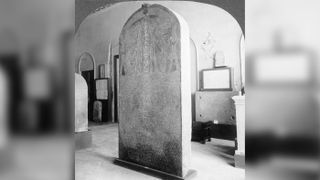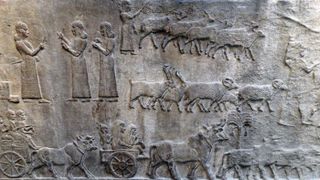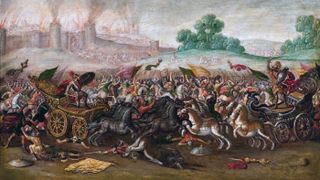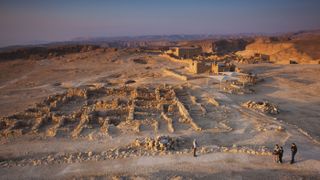Ancient Israel: History of the kingdoms and dynasties formed by ancient Jewish people
Archaeological excavation and the Hebrew Bible help scholars piece together the storied history.

The term "ancient Israel" is used by scholars to refer to the tribes, kingdoms and dynasties formed by ancient Jewish people in the Levant (an area that encompasses modern-day Israel, Palestine, Lebanon, Jordan and Syria).
Scholars draw mainly on three sources to reconstruct the history of ancient Israel — archaeological excavations, the Hebrew Bible and texts that are not found in the Hebrew Bible. The use of the Hebrew Bible can be challenging for scholars — while some of the accounts are thought by many scholars to be mystical, others, such as Nebuchandezzar II's conquest of Jerusalem are known to have happened.
Early history
The earliest mention of the word "Israel" comes from a stele (an inscription carved on stone) found in Thebes (modern day Luxor) and erected by the ancient Egyptian pharaoh Merneptah, who reigned from around 1213 B.C. to 1203 B.C. The inscription mentions a military campaign in the Levant during which Merneptah supposedly "laid waste" to "Israel" among other kingdoms and cities in the region.
The Hebrew Bible claims that the Jewish people fled Egypt as refugees before arriving (with some divine help) in the Levant, where they started conquering territory from the local population — such as the Canaanites. When exactly this would have happened is unclear although it would have been more than 3,000 years ago. Whether there is any truth to this biblical account is a point of contention among modern-day scholars. Some scholars think that there was no exodus from Egypt, while others believe that some Jewish people could have fled Egypt in the second millennium B.C.
James Hoffmeier, an archaeologist and professor at Trinity International University in Illinois, pointed out in papers and lectures that people from the Levant did live in ancient Egypt at different points in Egypt's history. He also noted that the ancient city of Ramesses, mentioned in the exodus stories told in the Hebrew Bible, did exist, and archaeologists have discovered that it flourished for several centuries during the second millennium B.C., before it was abandoned about 3,100 years ago.
King David

According to the Hebrew Bible, a man named David rose to become Israel's king after slaying a giant named Goliath in a battle that led to the rout of a Philistine army. King David then led a series of military campaigns that made Israel a powerful kingdom centered at Jerusalem, according to the Hebrew Bible.
After King David's death, possibly around 3,000 years ago, his son Solomon took over the kingdom and constructed what is now called the First Temple — supposedly the first purpose-built temple in which to worship God. The temple was located in Jerusalem and contained the Ark of the Covenant, which held tablets inscribed with the 10 Commandments. Recent archaeological excavations show that smaller temples also existed in Israel at the time the First Temple was flourishing.
Most of what scholars know about King David comes from the Hebrew Bible. However, fragments of an inscription found at the archaeological site of Tel Dan in 1993 mention a "House of David." The fragmented inscription dates back over 2,800 years. Although the meaning of the words is debated by scholars, many think it's evidence that a ruler named David really existed.
However, a number of archaeologists have noted that evidence for King David's supposedly vast kingdom is scarce. Jerusalem appears to have been sparsely populated around 3,000 years ago, Israel Finkelstein, a professor at Tel Aviv University, wrote in 2010.
"Over a century of archaeological explorations in Jerusalem — the capital of the glamorous biblical United Monarchy — failed to reveal evidence for any meaningful 10th-century building activity," Finkelstein wrote in a paper published in 2010 in the book "One God? One Cult? One Nation: Archaeological and Biblical Perspectives" (De Gruyter, 2010). Finkelstein wrote that King David's kingdom was likely a more modest state than the one described in the Hebrew Bible.
Over the last decade, a 3,000-year-old site called Khirbet Qeiyafa has been excavated by a team of archaeologists. The site is located west of Jerusalem, and the excavators believe it was controlled by King David. They even claim to have found a palace that may have belonged to King David, Live Science reported in 2013.
Northern & southern kingdoms
After King Solomon's death in around 930 B.C., the kingdom split into a northern kingdom, which retained the name Israel, and a southern kingdom called Judah, named after the tribe of Judah that dominated the new kingdom. Accounts in the Hebrew Bible suggest that grievances over taxes and corvée labor (free labor that had to be done for the state) played a role in the breakup.
The Hebrew Bible says that at the time of the breakup an Egyptian pharaoh named Shishak launched a military campaign in the Levant , where he carried out a successful raid of Jerusalem (capital of the kingdom of Judah) and took war booty back home.
Ancient Egyptian records say that around this time a pharaoh named Sheshonq I ruled Egypt. Sheshonq launched a military campaign into the Levant and conquered a number of settlements, according to these records. However, it's unclear from the surviving evidence whether he successfully attacked Jerusalem. Many scholars believe that the names Shishak and Sheshonq refer to the same pharaoh.
Israel and Judah co-existed for about two centuries, although they often fought each other. Israel also fought against a non-Jewish kingdom called Moab, which was located largely in modern-day Jordan. A ninth-century B.C. stele created by a Moabite king discusses the conflict between Israel and Moab; it is now in the Louvre Museum in Paris.
Assyrian involvement

Between the ninth and seventh centuries B.C., the Assyrian Empire, originally from the region that is now northern Iraq, grew in size and conquered an empire that stretched from modern-day Iraq to the borders of Egypt. As the Assyrian Empire grew, it came into contact with both Israel and Judah. The Black Obelisk of Shalmaneser III claims that an Israeli king named Jehu was forced to pay tribute to the Assyrian king Shalmaneser III (reign 859 to 824 B.C.); the obelisk is now in the British Museum.
The Hebrew Bible states that during the rule of Israel's King Pekah (who reigned around 735 B.C.), the Assyrian king Tiglath-Pileser III (who reigned from 745 to 727 B.C.) launched a military campaign that conquered several cities from Israel. Pekah was assassinated around 732 B.C. as Israel's losses mounted, and a new king named Hoshea took control of what was left of Israel.
Accounts recorded in the Hebrew Bible suggest that the Assyrian campaign against Israel was part of a larger war in which Israel and Judah fought against each other — the Assyrians sided with Judah, while a kingdom named Aram sided with Israel.
Hoshea was forced to pay tribute to the Assyrians, the Hebrew Bible says. He later rebelled but was crushed by Assyrian forces around 723 B.C. (the exact date is not clear). The kingdom of Israel then came to an end, and its remaining territory was incorporated into the Assyrian Empire. Many Israelites were deported to Assyria. The Hebrew Bible says that Judah was the last Jewish kingdom standing, although it was forced to pay tribute to Assyria.
In 705 B.C., Sennacherib ascended the throne of Assyria, and launched a military campaign against Judah that culminated in the siege of Jerusalem in 701 B.C. Both the Hebrew Bible and cuneiform texts tell of the siege. The Hebrew Bible says that Taharqa, a ruler who controlled both Nubia and Egypt, marched against Sennacherib, which may have helped end the siege. The Hebrew Bible also says that at one point, "The angel of the Lord went out and put to death a hundred and eighty-five thousand in the Assyrian camp. When the people got up the next morning — there were all the dead bodies!" (2 Kings 19:35 and Isaiah 37:36)
Cuneiform texts written by the Assyrians also say that Sennacherib failed to take Jerusalem. They don't specify why, only saying that Sennacherib trapped Hezekiah, the king of Judah, in Jerusalem "like a caged bird" and that the Assyrian king captured other cities that Hezekiah had controlled. The Assyrian texts claim that Hezekiah paid an enormous tribute to Sennacherib before the Assyrian king went home.
Fall of Judah & Babylonian exile

Ultimately, it wasn't the Assyrian Empire that destroyed Judah. Nearly a century after Sennacherib's unsuccessful siege of Jerusalem, a Babylonian king named Nebuchadnezzar II conquered much of Assyria's former empire and laid siege to Jerusalem. His forces conquered the city in 587 B.C., destroyed the First Temple, along with much of the rest of Jerusalem, and deported many of Judah's inhabitants to Babylonia (modern-day southern Iraq). Both the Hebrew Bible and cuneiform tablets that were written in Nebuchadnezzar II's time recorded these events.
The fate of the Ark of the Covenant, which was housed in the First Temple is unknown. Some ancient writers said that the ark was brought back to Babylon, while others suggested that it was hidden away. In the millennia after the destruction of the First Temple, a number of stories were spun about the supposed location of the lost Ark.
In recent years, a number of cuneiform tablets have emerged from Iraq that reveal details of the lives of some of the Jewish deportees. Many of these tablets were purchased by private collectors on the antiquities market, raising concerns that some of the tablets may have been looted.
The tablets give details on Jewish people who lived at a village called Āl-Yahūdu, which in Akkadian means the "village of Judea." The tablets were "written by Babylonian scribes on behalf of the Judean families that lived in and around Āl-Yahūdu," Kathleen Abraham, a professor at the University of Leuven in Belgium, wrote in a paper for an exhibition catalog, "Light and Shadows: The Story of Iran and the Jews" (Beit Hatfutsot, 2011).
The "tablets show that the exiles and their descendants had, at least to some extent, adopted the local language, script and legal traditions of Babylonia a relatively short time after their arrival there," Abraham wrote.
The Babylonians were eventually conquered by the ancient Persians in 539 B.C., and the Persian king Cyrus the Great (died circa 530 B.C.) gave the Jews permission to return to Jerusalem.
The Hasmonean Dynasty
The Persian Empire was virtually destroyed in the fourth century B.C. after suffering a series of stunning defeats at the hands of Alexander the Great, who went on to conquer an empire that stretched from Macedonia to Afghanistan. Even before Alexander's time, Greek forces launched raids on Persian territories, including Israel; a 2,500-year-old helmet that may be from a Greek raid was found in Haifa harbor in 2007.
Alexander's empire rapidly fell apart following his death in 323 B.C.. One of his generals, Seleucus Nicator, formed an empire that eventually controlled ancient Israel. The "Seleucid Empire" as it is called by modern-day historians, was passed down through the Seleucid family line for about 250 years.
The Seleucid Empire began to weaken during the 2nd century B.C., and a line of Jewish rulers descended from a priest named Simon Maccabeus gained semi-autonomy and eventually full independence from the Seleucids. This line of rulers is called the Hasmonean dynasty by modern-day scholars. By 100 B.C., the Hasmoneans had gained control of the territory that was once controlled by Israel and Judah, as well as territories that those kingdoms had never controlled, such as some areas of Jordan.
However, the Hasmonean dynasty's success proved short-lived. Roman power grew in the eastern Mediterranean during the first century B.C., taking territory in Anatolia during the late second and early first centuries B.C — gradually inching closer to Hasmonean territory. The Roman general Gnaeus Pompeius Magnus, more commonly known as Pompey the Great, took advantage of a Hasmonean civil war to launch a military expedition into Hasmonean territory. Jerusalem fell to Pompey in 63 B.C. and from that point on the territories that the Hasmoneans controlled were effectively under Roman rule — with Herod the Great eventually being named as a client king.
Herod the Great

While the Romans held sway over the former Hasmonean territories, they didn't impose Roman rule directly. Instead, a number of Jewish rulers controlled the territories as client kings of Rome.
The most famous of these client kings was Herod the Great (who lived circa 73 B.C. to 4 B.C.). The Roman general Mark Antony was a key supporter of Herod and supplied the military strength necessary to cement Herod's position as king of Judea, Barry Strauss, a professor of history and classics, wrote in his book "The War That Made the Roman Empire: Antony, Cleopatra and Octavian at Actium" (Simon & Schuster, 2022). Despite this, Antony also forced Herod to cede land to Cleopatra VII, Strauss wrote.
Herod became well known for his building achievements. "Without a doubt he [Herod] was the greatest builder in the Holy Land, planning and overseeing the execution of palaces, fortresses, theatres, amphitheatres, harbours and the entire city of Caesarea, and to crown them all, he organized the rebuilding of the Temple of Jerusalem," Geza Vermes, who was professor emeritus of Jewish Studies at Oxford University in the U.K., wrote in his book "The True Herod" (Bloomsbury, 2014).
Herod built what is today called the Second Temple in Jerusalem, a replacement of sorts for the First Temple that had been destroyed by the Babylonians in 587 B.C. Herod also constructed a series of palaces at Masada.
Biblical literature often vilifies Herod, claiming that he tried to seek out and kill Jesus when he was a baby, as he supposedly perceived the infant as a threat to his rule. One biblical story claims that he killed all the infants living in Bethlehem in hopes of killing Jesus. Scholars are generally skeptical of these biblical claims and doubt that they actually happened.
Some scholars think that a group called the Essenes established a retreat at Qumran during or shortly after King Herod's reign. The Dead Sea Scrolls — thousands of fragments from 900 manuscripts — were found in 11 nearby caves near Qumran in the 1940s and 1950s. An additional scroll was found blank inside another cave in 2017. Some of the scrolls contain parts of the Hebrew Bible while others include calendars, community rules and astronomical texts.
Rebellions against Rome
After Herod's death around 4 B.C., Rome asserted more control over the area and ruled parts of Israel directly. These parts were governed by prefects who were appointed by Rome — such as Pontius Pilate.
Tensions between the region's Jewish inhabitants and Roman rulers increased and came to a head in A.D. 66. A rebellion in A.D. 70 culminated in the siege of Jerusalem and the destruction of the Second Temple by Roman forces. Resistance continued after the city's fall — the rebels' last major stronghold was at Masada; it didn't fall until A.D. 73 or A.D. 74, after a protracted Roman siege.
Masada's defenders were part of a group that modern-day scholars often refer to as the "Zealots." The ancient Jewish writer Josephus (who lived from A.D. 37 to 100) wrote that the Zealots took their own lives rather than surrender to the Romans. "For the husbands tenderly embraced their wives, and took their children into their arms, and gave the longest parting kisses to them, with tear in their eyes," before they committed suicide, Josephus wrote.
Further rebellions occurred over the decades. The final rebellion was crushed in A.D. 136. The Roman writer Cassius Dio (who lived circa. A.D. 155 to A.D. 235) wrote that this last rebellion led to the desolation of the Jewish population.
"Five hundred and eighty thousand men were slain in the various raids and battles, and the number of those that perished by famine, disease and fire was past finding out … thus nearly the whole of Judaea was made desolate," Dio wrote. (Translation by Earnest Cary, from volume VIII of the "Loeb Classical Library" published in 1925). Archaeologists are still finding treasure hoards buried by people who lived during this rebellion.
In the millennia afterward, the Jewish diaspora spread throughout the world. The modern state of Israel was established in 1948, with Jerusalem as its capital.
The Israel Museum in Jerusalem holds many of the Dead Sea Scrolls and numerous artifacts from Israel's ancient and modern history. Archeologists plan to restart excavations at Masada in 2023 — more information on their finds and plans can be found on the excavation's website.
Additional resources
- The site study.com has a video and resources on daily life in ancient Israel.
- The Biblical Archaeology Society has loads of features on ancient Israel, along with information about live events and digs.
- The World History Encyclopedia provides an in-depth look at Herod the Great.
Bibliography
Yeroushalmi, David, ed, "Light and Shadows: The Story of Iran and the Jews" Fowler Museum at UCLA, 2012
Hoffmeier, James. "Ancient Israel in Sinai: The Evidence for the Authenticity of the Wilderness Narrative" Oxford University Press, 2005
Kratz, Reinhard G. and Spieckermann, Hermann (eds) "One God? One Cult? One Nation: Archaeological and Biblical Perspectives" De Gruyter, 2010
Strauss, Barry "The War That Made the Roman Empire: Antony, Cleopatra and Octavian at Actium" Simon & Schuster, 2022
Vermes, Geza, "The True Herod" Bloomsbury, 2014
Sign up for the Live Science daily newsletter now
Get the world’s most fascinating discoveries delivered straight to your inbox.

Owen Jarus is a regular contributor to Live Science who writes about archaeology and humans' past. He has also written for The Independent (UK), The Canadian Press (CP) and The Associated Press (AP), among others. Owen has a bachelor of arts degree from the University of Toronto and a journalism degree from Ryerson University.